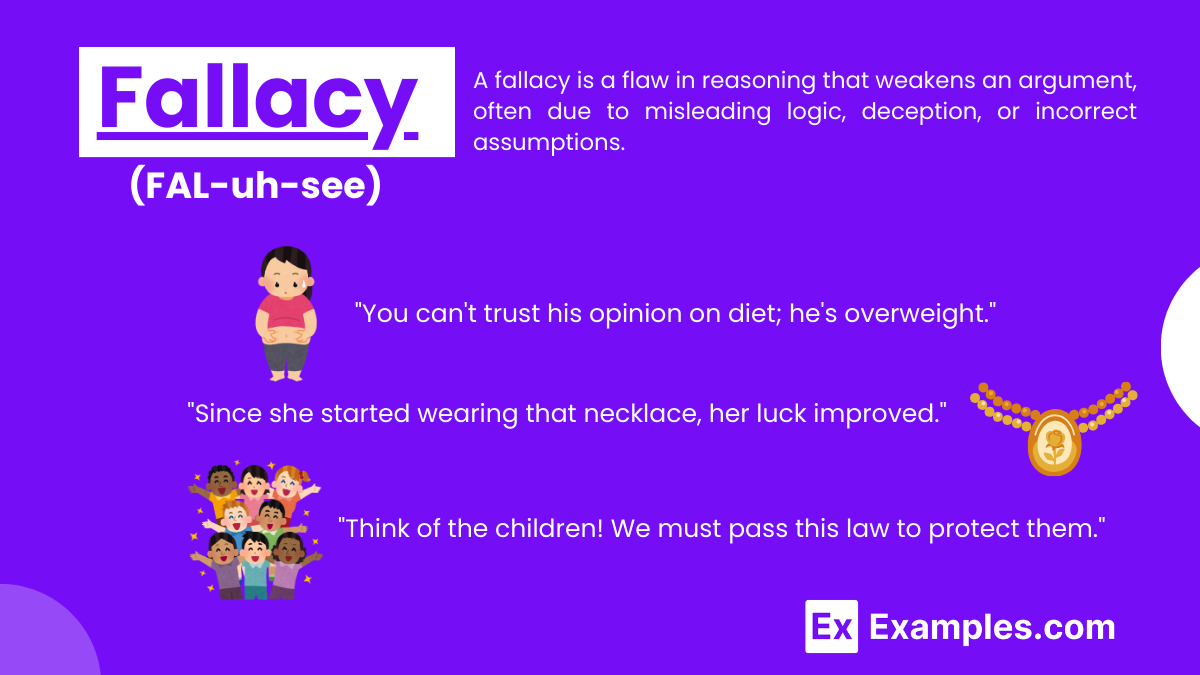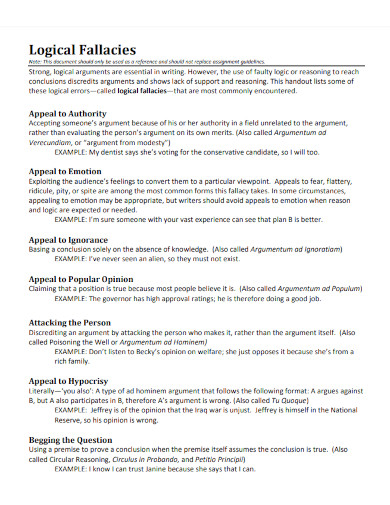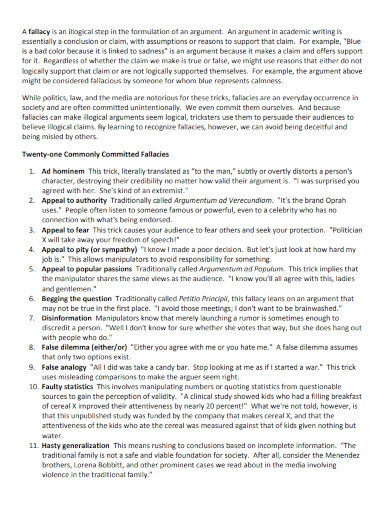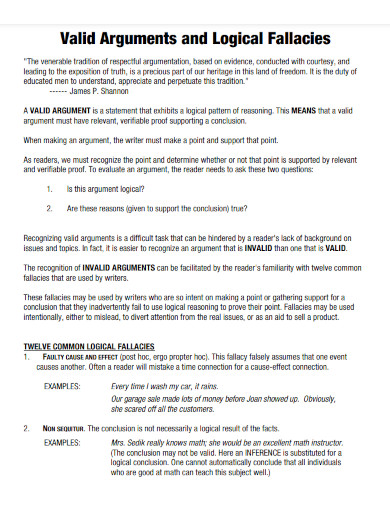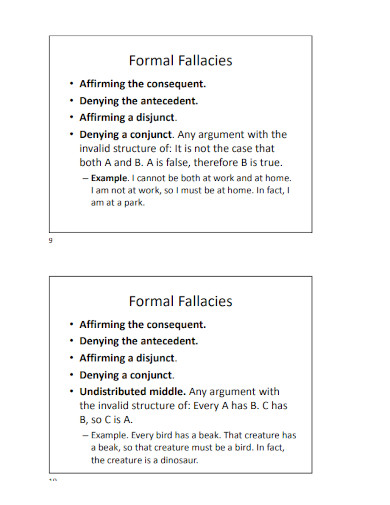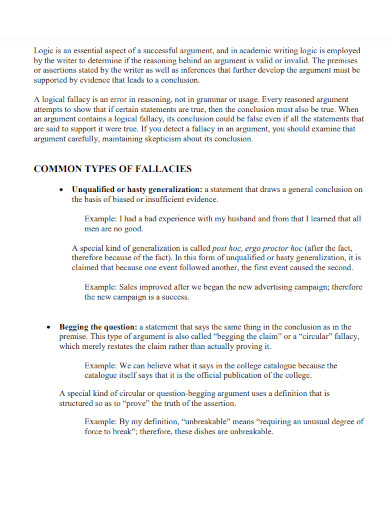50+ Fallacy Examples
Annotating is a method of actively reading books or articles. Reading challenging articles will get easier for you as you become more adept at annotation, which requires practice. This practice will not only help you read and consume reading materials but will also provide extra insight into the text, revealing literary devices, false fallacies, and logical fallacies. This deeper understanding will enhance your critical thinking and appreciation of the text’s nuances and arguments.
What is Fallacy?
A fallacy is a flaw in reasoning that weakens an argument’s validity. It occurs when the logic of an argument is flawed, leading to a misleading or unsound conclusion. Fallacies can stem from various sources, such as faulty logic, deceptive rhetoric, or misunderstandings. They are often used, intentionally or unintentionally, to persuade others while bypassing genuine evidence or logical coherence. Common types of fallacies include ad hominem attacks, where the person is attacked instead of the argument; straw man arguments, where an opponent’s position is misrepresented to be easily refuted; and false dilemmas, which present limited options when more exist. Recognizing fallacies is crucial for critical thinking, as they can obscure the truth and hinder effective decision-making.
Fallacy Examples
Ad Hominem Fallacy: Attacking the person instead of addressing the argument.
- “You can’t trust his opinion on climate change because he’s not a scientist.”
Straw Man Fallacy: Misrepresenting someone’s argument to make it easier to attack.
- “He wants to reduce military spending, so he must want to leave our country defenseless.”
False Dilemma Fallacy (Black-or-White Fallacy): Presenting two options as the only possibilities when more exist.
- “Either you support the new policy, or you don’t care about our city’s future.”
Appeal to Authority Fallacy: Assuming a claim is true because an authority figure believes it.
- “The CEO says this strategy will work, so it must be the best approach.”
Slippery Slope Fallacy: Assuming one action will lead to a series of negative events without proof.
- “If we allow students to redo assignments, soon they’ll expect to pass without any effort.”
Circular Reasoning Fallacy: The argument’s conclusion is used as a premise without proper justification.
- “He’s a great leader because he always makes great decisions.”
Hasty Generalization Fallacy: Drawing a conclusion based on insufficient or biased evidence.
- “My neighbor is rude, so everyone in this town must be unfriendly.”
Red Herring Fallacy: Introducing an irrelevant topic to divert attention from the original issue.
- “Why worry about pollution? We should focus on how dangerous texting while driving is.”
Bandwagon Fallacy: Assuming something is true or right because it is popular.
- “Everyone is using this diet plan, so it must be effective.”
Post Hoc Ergo Propter Hoc Fallacy (False Cause Fallacy): Assuming that because one event followed another, it was caused by it.
- “I wore my lucky shirt, and we won the game. The shirt must be why we won.”
Fallacy Sentence Examples
- “She must be right about the new law because she’s a well-known lawyer.”
- “If we don’t ban fast food, obesity rates will skyrocket uncontrollably.”
- “All politicians are corrupt; just look at that recent scandal.”
- “He failed the test because the teacher doesn’t like him.”
- “The new software is bad because everyone in my office says so.”
- “You shouldn’t listen to his advice on finances because he went bankrupt once.”
- “If we accept this new regulation, soon the government will control every aspect of our lives.”
- “My grandfather smoked every day and lived until 90, so smoking can’t be that bad.”
- “Why worry about your health when there are so many people suffering from poverty?”
- “You have to agree with the new policy because everyone else in the company does.”
1. Logical Fallacies Template
2. Introduction to Fallacies
3. Valid Arguments and Logical Fallacies
4. Logical Fallacies Philosophical Logic
5. Informal Fallacy Template
6. Writing Process Logical Fallacy
Fallacy Examples in Real Life
- False Cause Fallacy: “I failed my exam because the test was on a Monday. Mondays are always unlucky for me.”
- Appeal to Ignorance: “No one has proven that aliens don’t exist, so they must be out there.”
- Bandwagon Fallacy: “Everyone is buying this new phone, so it must be the best one available.”
- Slippery Slope Fallacy: “If we allow people to work from home, soon no one will come to the office, and productivity will plummet.”
- Ad Hominem Fallacy: “You can’t take his advice on healthy eating; he’s overweight.”
Fallacy Examples in Media
- Straw Man Fallacy: “Opponents of the new education policy just want our kids to fail.”
- Red Herring Fallacy: “The senator’s stance on healthcare is questionable, but what about his opponent’s past financial issues?”
- Hasty Generalization: “A few tech companies have data breaches, so all tech companies must be irresponsible with user data.”
- Appeal to Emotion: “If you care about your children’s future, you’ll support this political candidate.”
- False Dilemma Fallacy: “The news segment argued that we either ban all guns or accept constant violence in our streets.”
Fallacy Examples in Literature
- Ad Hominem Fallacy: In Arthur Miller’s The Crucible, characters discredit others by attacking their character rather than addressing the accusations.
- False Cause Fallacy: In Shakespeare’s Julius Caesar, Cassius suggests that Caesar’s rise to power is the cause of Rome’s troubles without clear evidence.
- Straw Man Fallacy: In George Orwell’s Animal Farm, Squealer misrepresents Snowball’s intentions to consolidate Napoleon’s power.
- Slippery Slope Fallacy: In Ray Bradbury’s Fahrenheit 451, the society assumes that allowing books will lead to chaos and anarchy.
- Hasty Generalization: In Harper Lee’s To Kill a Mockingbird, some characters generalize that all black people are untrustworthy based on prejudiced beliefs rather than evidence.
Fallacy Examples in Advertising
- “Four out of five dentists recommend this toothpaste, so it must be the best.”
- “Buy our product now and avoid missing out on this incredible deal!”
- “Our cereal is the choice of champions—eat it and you’ll be a champion too.”
- “This skincare product is used by celebrities, so it will work wonders for you.”
- “Our weight loss supplement guarantees you’ll shed pounds fast, unlike those other brands.”
Fallacy Examples in Commercials
- “If you don’t use this antivirus software, your computer will definitely get a virus.”
- “Switch to our insurance, or you’ll be wasting your money.”
- “Our brand of soda is the only one that will truly quench your thirst.”
- “Choose our internet service, the fastest available, because slow internet is the worst.”
- “Only our shampoo can give you the silky, smooth hair you’ve always wanted.”
False Dilemma Fallacy Examples
- “Either you’re with us, or you’re against us.”
- “We must ban all cars in the city center, or we’ll never solve the traffic problem.”
- “You can either go to college or work a minimum-wage job for the rest of your life.”
- “Support this policy, or face economic disaster.”
- “Vote for this candidate, or the country will fall apart.”
False Cause Fallacy Examples
- “I wore my lucky socks and we won the game, so the socks must be why we won.”
- “The crime rate dropped after the new mayor took office, so the mayor must be the cause.”
- “After I started drinking green tea, I lost weight. The tea must be responsible.”
- “We haven’t had any accidents since we installed that new coffee machine. It must be keeping everyone alert.”
- “Sales increased when we changed our logo, so the new logo must be the reason.”
Types of Fallacy
- Ad Hominem Fallacy
- Definition: Attacking the person making the argument rather than the argument itself.
- Example: “You can’t trust his opinion on environmental policy because he’s a high school dropout.”
- Straw Man Fallacy
- Definition: Misrepresenting someone’s argument to make it easier to attack.
- Example: “He wants to regulate industry, so he must want to destroy our economy.”
- False Dilemma (False Dichotomy)
- Definition: Presenting two options as the only possibilities when more exist.
- Example: “You either support our plan, or you’re against us.”
- Slippery Slope Fallacy
- Definition: Arguing that a small first step will inevitably lead to a chain of related events culminating in a significant (usually negative) effect.
- Example: “If we allow students to redo assignments, soon they’ll expect to get As without doing any work.”
- Circular Reasoning (Begging the Question)
- Definition: The argument’s conclusion is used as a premise without proper justification.
- Example: “He is a great leader because he leads well.”
- Hasty Generalization
- Definition: Making a broad generalization based on insufficient or biased evidence.
- Example: “My two friends got sick after eating there, so the restaurant must have bad food.”
- Red Herring Fallacy
- Definition: Introducing an irrelevant topic to divert attention from the original issue.
- Example: “Why worry about climate change when there are so many homeless people?”
- Bandwagon Fallacy
- Definition: Assuming something is true or right because it is popular.
- Example: “Everyone is using this diet plan, so it must be effective.”
- Appeal to Authority
- Definition: Asserting a claim is true because an authority or expert believes it to be true.
- Example: “This medicine must be effective because my doctor said so.”
- False Cause (Post Hoc Ergo Propter Hoc)
- Definition: Assuming that because one event followed another, it was caused by it.
- Example: “We had a great sales month after hiring the new manager, so the new manager must be the reason.”
- Appeal to Emotion
- Definition: Manipulating an emotional response instead of presenting a logical argument.
- Example: “Think of the children! We must pass this law to protect them.”
- Equivocation
- Definition: Using an ambiguous term in more than one sense, thus making an argument misleading.
- Example: “The sign said ‘fine for parking here,’ so I assumed it was fine to park.”
- Appeal to Ignorance
- Definition: Claiming something is true because it has not been proven false.
- Example: “No one has proven that aliens don’t exist, so they must be out there.”
- Tu Quoque (You Too)
- Definition: Responding to criticism by accusing the critic of the same issue.
- Example: “You can’t criticize me for cheating on the test; you cheated last year.”
- False Analogy
- Definition: Making a comparison between two things that are not truly comparable.
- Example: “Employees are like nails; you have to hit them on the head to get them to work.”
Functions of Fallacy
- Distracting from Weak Arguments: Fallacies can divert attention away from the weaknesses in an argument by focusing on irrelevant or emotional points, thus misleading the audience.
- Manipulating Emotions: Many fallacies, such as the appeal to emotion, aim to evoke an emotional response rather than logical reasoning, influencing opinions and decisions based on feelings rather than facts.
- Simplifying Complex Issues: Fallacies often reduce complex issues to overly simple choices or outcomes, as seen in false dilemmas, making it easier to persuade an audience without addressing the intricacies.
- Attacking Opponents: Ad hominem fallacies function to discredit opponents personally rather than addressing their arguments, thereby weakening their position without engaging in substantive debate.
- Creating Illusions of Validity: Fallacies can create a false sense of legitimacy for an argument by using misleading comparisons, irrelevant authorities, or unproven claims, making flawed reasoning seem logical.
- Shifting the Burden of Proof: Fallacies like the appeal to ignorance shift the burden of proof to the opponent, asserting that a claim must be true because it hasn’t been proven false, thus avoiding the need for proper evidence.
- Reinforcing Prejudices and Biases: Fallacies often play on existing prejudices and biases, such as hasty generalizations or stereotypes, reinforcing these views without critical examination.
- Evasion and Redirection: Red herring fallacies function to evade difficult questions or redirect the conversation to safer, unrelated topics, thereby avoiding scrutiny of the original argument.
- Encouraging Conformity: Bandwagon fallacies appeal to the desire to fit in or be part of the majority, persuading people to accept a claim based on its popularity rather than its validity.
- Providing False Certainty: Fallacies like false cause provide a misleading sense of certainty by implying causation where there is only correlation, thus convincing the audience of false conclusions.
How to Write Fallacy
- Understand the Fallacy: Familiarize yourself with different types of fallacies, their definitions, and examples. This foundation helps in identifying and explaining them effectively.
- Identify the Argument: Clearly state the argument or claim being analyzed. Provide context so readers understand the situation or discussion where the fallacy occurs.
- Name the Fallacy: Identify the specific fallacy used in the argument. Be precise in naming it to avoid confusion.
- Explain the Fallacy: Describe why the argument is fallacious. Break down the reasoning process and highlight where it goes wrong.
- Provide Examples: Use clear and relevant examples to illustrate the fallacy. These can be real-life situations, hypothetical scenarios, or well-known arguments.
- Compare and Contrast: If applicable, compare the fallacy with similar or related fallacies to show distinctions and nuances. This helps deepen understanding.
- Show the Impact: Explain the consequences of using the fallacy. Discuss how it undermines the argument and affects the overall discussion or decision-making process.
- Offer Corrections: Suggest how the argument could be improved or restructured to avoid the fallacy. Provide logical, fallacy-free alternatives.
- Use Clear Language: Write in clear, concise language. Avoid jargon or overly complex sentences to ensure your explanation is accessible.
- Review and Revise: Check your work for clarity, coherence, and accuracy. Make sure your explanations are logical and your examples are illustrative.
Example of Writing About a Fallacy
Claim: “You can’t trust anything she says about climate change because she’s not a scientist.”
Fallacy Identified: Ad Hominem Fallacy
Explanation: This argument attacks the person making the claim (she’s not a scientist) rather than addressing the actual argument about climate change. By focusing on her qualifications instead of the evidence or reasoning she provides, the argument becomes fallacious.
Example: For instance, if a non-scientist presents well-researched data on climate change, dismissing their argument solely based on their profession ignores the validity of their evidence.
Impact: Using an ad hominem fallacy distracts from the real issue and undermines constructive debate. It can prevent valuable information from being considered based on irrelevant criteria.
Correction: Instead of dismissing her arguments due to her lack of scientific credentials, evaluate the evidence and reasoning she presents. Address any specific flaws or strengths in her argument directly related to climate change data.
Why are fallacies important to identify?
Identifying fallacies is crucial for critical thinking, as they can obscure the truth and weaken the validity of arguments.
What is an ad hominem fallacy?
An ad hominem fallacy attacks the person making the argument rather than the argument itself.
What is a straw man fallacy?
A straw man fallacy misrepresents an opponent’s argument to make it easier to attack and refute.
What is a false dilemma?
A false dilemma presents two options as the only possibilities when more alternatives exist, oversimplifying the issue.
What is a slippery slope fallacy?
A slippery slope fallacy assumes that a small first step will inevitably lead to a chain of related negative events.
What is a red herring fallacy?
A red herring fallacy introduces an irrelevant topic to divert attention from the original issue.
What is a bandwagon fallacy?
A bandwagon fallacy assumes something is true or right because it is popular or widely accepted.
What is a false cause fallacy?
A false cause fallacy assumes that because one event followed another, it was caused by it, without proof.
How can fallacies impact decision-making?
Fallacies can lead to poor decision-making by presenting misleading or invalid arguments, which can obscure the truth.



